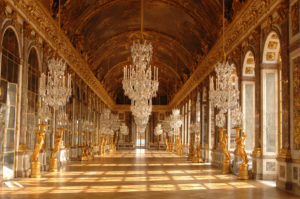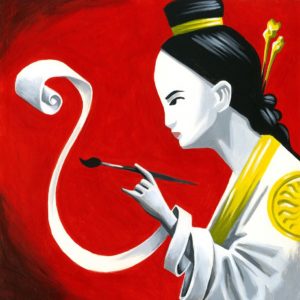The strict etiquette at Wimbledon and other tournaments is a reminder that the sport’s first players were French kings and aristocrats.
June 15, 2023
For the 136th Wimbledon Championships, opening on July 3, lady competitors will be allowed to ignore the all-white clothing rule for the first time—though only as it applies to their undergarments. Tennis may never be the same.
The break with tradition is all the more surprising given the sport’s penchant for strict etiquette rules and dress codes. The earliest recorded version of tennis was a type of handball played by medieval monks in France. Called “jeu de paume,” “game of the palm,” it involved hitting a leather ball against the cloister wall.

Thomas Fuchs
As the sport spread beyond the monastic world, it gained a new name, “tenez,” the French word for “receive.” It had instant social cachet, since it could only be played in large, high-walled courtyards, thus narrowing the pool of players to kings and aristocrats.
Early “tenez” was not without its dangers. Legend has it that King Louis X of France, who introduced the first covered courts, took ill and died after an overly strenuous match in 1316. In 1498 another French king, Charles VIII, suffered an untimely end after banging his head on a lintel while hurrying to his tennis court.
By the 16th century, the game had evolved into something in between modern squash and tennis. Players used angled wooden rackets, and the ball could be bounced off the walls and sloping roof as well as hit over the net. This version, known as real or royal tennis, is still played at a small number of courts around the world.
The Royal Tennis Court at King Henry VIII’s Hampton Court Palace, outside London, was the most luxurious in Europe, but the sophisticated surroundings failed to elevate on-court behavior. In 1541, Sir Edmund Knyvett was condemned to have his hand chopped off for striking his opponent and drawing blood. Henry ended up granting him a reprieve—more than he did for wives two and five.
The association of tennis with royal privilege hastened its demise in the 18th century. On June 20, 1789, Louis XVI’s tennis court at Versailles hosted one of the most important events of the French Revolution. The new National Assembly gathered there after being locked out of its premises, and made a pledge, the Tennis Court Oath, not to disband until France had a constitution. It was a very brave or very foolish person who played the game after that.
Modern tennis—known at first as “lawn tennis,” since it was played on a grass court—began to emerge in the 1870s, when an eccentric British Army major named Walter Clopton Wingfield invented a version of the game using rubber balls. His name for it—“Sphairistike,” from the Greek word for ball playing—never caught on. But the social opportunities offered by tennis made it extremely popular among the upper classes.
The exclusive All England Croquet and Lawn Tennis Club in Wimbledon, whose championships began in 1877, inspired imitators on both sides of the Atlantic. Unfortunately, many tennis players expended nearly as much effort keeping the “wrong sort” out as they did keeping the ball in. For years, the major tennis tournaments offered no prizes and were only open to amateurs, meaning the wealthy. Professionals were relegated to a separate circuit.
Tennis’s own revolution took place in 1968, following sustained pressure from players and fans for the Grand Slam Tournaments to be open to all competitors. Fifty-five years on, the barricades—and the barriers—are still coming down.







 Western Europe had nothing comparable to Weiyang until King Louis XIV built the Palace of Versailles in 1682. With its unparalleled opulence—particularly the glittering Hall of Mirrors—and spectacular gardens, Versailles was a cult of personality masquerading as architecture. Louis, the self-styled Sun King at the center of this artificial universe, created a living stage where seeing and being seen was the highest form of social currency.
Western Europe had nothing comparable to Weiyang until King Louis XIV built the Palace of Versailles in 1682. With its unparalleled opulence—particularly the glittering Hall of Mirrors—and spectacular gardens, Versailles was a cult of personality masquerading as architecture. Louis, the self-styled Sun King at the center of this artificial universe, created a living stage where seeing and being seen was the highest form of social currency.